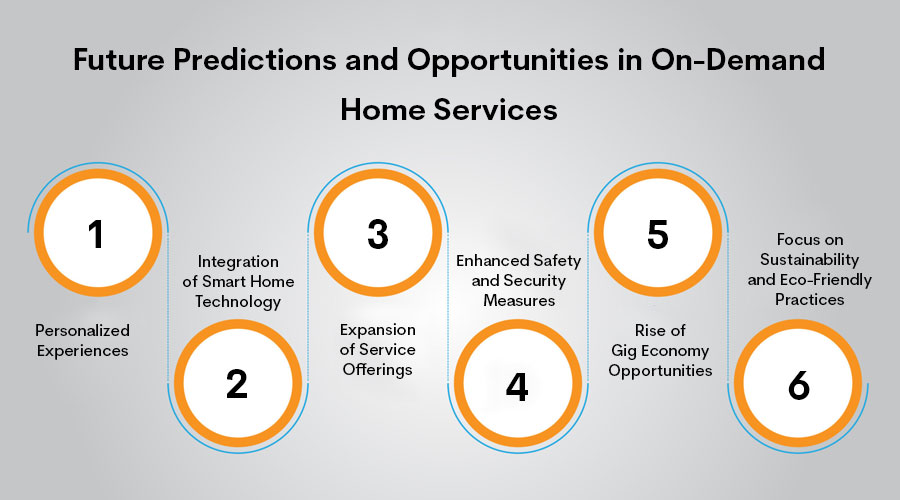Table of Contents
Introduction to On-Demand Home Services Apps
In the bustling world we live in today, time is a precious commodity. Balancing work, family, and personal commitments often leaves little room for mundane tasks like fixing a leaky faucet or cleaning the gutters. This is where on-demand home services apps step in, revolutionizing the way we address our household needs.
What Are On-Demand Home Services Apps?
On-demand home services apps are digital platforms that connect users with a network of service providers for various household tasks. Whether you need a plumber, electrician, cleaner, or handyman, these apps offer a convenient solution at the tap of a screen.
How Do They Work?
The process is simple and user-friendly. Users download the app, create an account, and browse through a list of available services. They can specify their requirements, such as the type of service needed, preferred time, and location. Once the request is submitted, the app matches the user with relevant service providers in their area. Users can view profiles, ratings, and reviews of providers before making a selection.
Key Features and Benefits
- Convenience: On-demand home services apps offer unparalleled convenience. Users can book services anytime, anywhere, eliminating the need for lengthy phone calls or scheduling hassles.
- Wide Range of Services: From plumbing and electrical work to home cleaning and furniture assembly, these apps cover a diverse range of household needs.
- Quality Assurance: Users can review ratings and feedback from previous customers, ensuring they choose reliable and skilled service providers.
- Transparent Pricing: Most apps provide upfront pricing estimates based on the scope of work, allowing users to budget accordingly.
- Safety and Security: Service providers undergo background checks and verification processes, giving users peace of mind when inviting them into their homes.
- 24/7 Support: In case of any issues or emergencies, users can access customer support services round the clock.
Popular On-Demand Home Services Apps
- TaskRabbit: Known for its versatility, TaskRabbit connects users with skilled “Taskers” for various tasks ranging from home repairs to furniture assembly.
- Handy: Specializing in home cleaning, repairs, and installations, Handy offers reliable services with upfront pricing and easy booking options.
- Thumbtack: Thumbtack matches users with local professionals for a wide range of services, including home improvement, maintenance, and personal care.
- UrbanClap (now Urban Company): Operating in several countries, UrbanClap provides on-demand services for home cleaning, repairs, beauty, and wellness.
- HomeAdvisor: With a focus on home improvement and maintenance, HomeAdvisor connects users with screened and approved service professionals in their area.
The Evolution of Home Services Industry
In the vast tapestry of human history, the concept of home and its maintenance has been a constant thread. From the earliest civilizations to the modern digital era, the evolution of the home services industry reflects not only advancements in technology but also shifts in societal needs and expectations.
Ancient Beginnings: The roots of the home services industry stretch back to ancient times. In early civilizations such as Mesopotamia, Egypt, and Rome, specialized tradesmen emerged to cater to the needs of homeowners. These artisans, skilled in carpentry, masonry, and plumbing, provided essential services to construct and maintain dwellings.
Middle Ages and Renaissance: During the Middle Ages and the Renaissance period, guilds and apprenticeships flourished, laying the groundwork for modern trade unions and professional associations. The rise of urban centers saw the emergence of specialized craftsmen, from blacksmiths to glassmakers, who contributed to the expansion and beautification of homes.
Industrial Revolution: The Industrial Revolution heralded a profound transformation in the home services industry. Mass production and technological innovations revolutionized manufacturing processes, making household appliances and tools more accessible to the average homeowner. This era saw the rise of services such as plumbing, electrical work, and appliance repair, as homes became increasingly electrified and mechanized.
20th Century: The 20th century witnessed unprecedented growth and specialization in the home services sector. The post-World War II economic boom led to the suburbanization of America and a surge in demand for construction, renovation, and landscaping services. The proliferation of television and print media facilitated the rise of advertising, enabling home service providers to reach a wider audience.
Digital Age: The advent of the internet and digital technologies has ushered in a new era of innovation and disruption in the home services industry. Online platforms and mobile apps connect homeowners with service providers, streamlining the process of scheduling appointments and obtaining quotes. Moreover, the rise of smart home technologies has created new opportunities for home automation and remote monitoring, transforming the way we manage and maintain our living spaces.
Future Trends: Looking ahead, the home services industry is poised for further evolution as emerging technologies such as artificial intelligence, augmented reality, and 3D printing reshape the landscape. Predictive analytics and IoT (Internet of Things) devices will enable proactive maintenance and predictive troubleshooting, minimizing downtime and reducing costs for homeowners.
Understanding the On-Demand Economy
In a world where convenience reigns supreme, the on-demand economy has emerged as a transformative force, reshaping the way we live, work, and interact with businesses. From ordering a ride with a tap on our smartphones to having groceries delivered to our doorstep within hours, the on-demand economy has revolutionized traditional business models and consumer expectations. But what exactly is the on-demand economy, and how does it work?
What is the On-Demand Economy?
The on-demand economy, also known as the “sharing economy” or “gig economy,” refers to a marketplace model where goods and services are provided to consumers on an as-needed basis, usually facilitated by digital platforms or mobile apps. This model enables individuals to access services quickly and conveniently, often with the click of a button, bypassing the traditional constraints of time and location.
Key Characteristics
- Instant Gratification: One of the defining features of the on-demand economy is its focus on instant gratification. Whether it’s transportation, food delivery, or household services, consumers expect quick and efficient service delivery.
- Flexible Workforce: The on-demand economy relies heavily on a flexible workforce of independent contractors or freelancers who provide services on a temporary or part-time basis. This flexibility allows individuals to work when and where they choose, fitting their schedules around other commitments.
- Digital Platforms: Digital platforms play a central role in connecting service providers with consumers in the on-demand economy. These platforms often use algorithms to match supply with demand, ensuring efficient resource allocation.
- User Ratings and Reviews: Trust is essential in the on-demand economy, and user ratings and reviews play a crucial role in building trust between consumers and service providers. Positive reviews can help attract more business, while negative reviews can have a significant impact on reputation.
Examples of On-Demand Services
- Transportation: Companies like Uber, Lyft, and Grab have transformed the way we think about transportation, allowing users to book rides on-demand with the tap of a button.
- Food Delivery: Services like DoorDash, Uber Eats, and Grubhub have made it easier than ever to order food from your favorite restaurants and have it delivered to your doorstep in record time.
- Accommodation: Platforms like Airbnb have disrupted the hospitality industry by allowing individuals to rent out their homes or spare rooms to travelers on a short-term basis.
- Freelance Work: Websites such as Upwork, Freelancer, and Fiverr connect businesses with freelance professionals offering a wide range of services, from graphic design to programming.
Challenges and Opportunities: While the on-demand economy offers numerous benefits, including convenience and flexibility, it also poses several challenges. These include concerns about worker rights and labor protections, regulatory issues, and questions about the long-term sustainability of the model.
However, despite these challenges, the on-demand economy continues to thrive, driven by technological advancements, changing consumer preferences, and evolving business models. As technology continues to evolve and society becomes increasingly interconnected, the on-demand economy is likely to play an even more significant role in shaping the future of commerce and consumer behavior.
Key Features of On-Demand Home Services Apps
In today’s fast-paced world, convenience is key, and on-demand home services apps are revolutionizing the way we tackle household tasks. From cleaning services to plumbing emergencies, these apps connect users with professionals at the tap of a button. But what exactly sets these apps apart? Let’s delve into the key features that make on-demand home services apps indispensable in modern life.
User-Friendly Interface: One of the primary reasons for the popularity of on-demand home services apps is their intuitive user interface. These apps are designed to be user-friendly, allowing even technologically challenged individuals to effortlessly navigate through various services. With simple menus, clear categories, and easy-to-understand icons, users can quickly find the service they need and book it within minutes.
Comprehensive Service Listings: On-demand home services apps boast a wide array of service listings to cater to diverse needs. Whether you require house cleaning, electrical repairs, pest control, or landscaping, these apps have you covered. Each service category is further divided into subcategories, ensuring that users can pinpoint their exact requirements without hassle. Additionally, users can access detailed descriptions of each service, along with pricing and availability, empowering them to make informed decisions.
Real-Time Booking and Scheduling: Gone are the days of waiting endlessly for service providers to confirm appointments. On-demand home services apps offer real-time booking and scheduling functionalities, allowing users to select preferred time slots that align with their schedules. Users can instantly check the availability of service providers and book appointments at their convenience. Moreover, these apps often integrate calendar syncing features, ensuring seamless coordination between users and service professionals.
Transparent Pricing and Payment Options: Transparency is paramount in on-demand home services apps, particularly concerning pricing and payment. Users can view upfront pricing for each service, eliminating any ambiguity or hidden costs. Additionally, these apps offer multiple payment options, including credit/debit cards, digital wallets, and sometimes even cash on delivery. Secure payment gateways ensure that transactions are safe and hassle-free, enhancing user trust and satisfaction.
Ratings and Reviews System: To maintain service quality and accountability, on-demand home services apps incorporate a robust ratings and reviews system. After availing a service, users can rate their experience and provide feedback, which is visible to other users. This system incentivizes service providers to deliver exceptional service consistently while helping users make informed decisions based on peer feedback.
Seamless Communication Channels: Effective communication is essential for a satisfactory service experience. On-demand home services apps facilitate seamless communication channels between users and service providers through in-app messaging or chat features. Users can communicate their requirements, provide additional instructions, or seek clarifications directly within the app, fostering clear and efficient communication throughout the service process.
GPS Tracking and Real-Time Updates: For added convenience and peace of mind, many on-demand home services apps offer GPS tracking and real-time updates. Users can track the location of service providers en route to their location and receive notifications upon their arrival. This feature not only enhances transparency but also enables users to plan their day accordingly, minimizing wait times and maximizing efficiency.
Popular On-Demand Home Services Categories
In today’s fast-paced world, convenience is key, and on-demand home services have emerged as a lifeline for busy individuals seeking assistance with various tasks. Whether it’s fixing a leaky faucet, cleaning the house, or even walking the dog, there’s a service available for almost every need. Let’s delve into some of the most popular on-demand home service categories that are revolutionizing the way we manage our households.
- Home Cleaning Services: A tidy home is essential for both physical and mental well-being. With on-demand home cleaning services, individuals can schedule professional cleaners to spruce up their living spaces at their convenience. From regular maintenance cleanings to deep-cleaning sessions, these services cater to diverse needs and preferences.
- Handyman Services: From minor repairs to major renovations, handyman services offer a wide range of solutions for household maintenance. Whether it’s fixing a leak, installing shelves, or assembling furniture, skilled professionals are just a booking away, saving homeowners time and effort.
- Lawn Care and Landscaping Services: A well-manicured lawn enhances the aesthetic appeal of any property. On-demand lawn care services provide assistance with mowing, trimming, weed control, and landscaping, allowing homeowners to maintain lush and vibrant outdoor spaces without the hassle of manual labor.
- Pet Care Services: Pets are an integral part of many households, but their care demands time and attention. On-demand pet care services offer pet sitting, dog walking, grooming, and veterinary assistance, ensuring that furry companions receive the love and care they deserve, even when their owners are busy.
- Home Maintenance and Repair Services: From electrical and plumbing issues to HVAC maintenance, home repair needs can arise unexpectedly. On-demand home maintenance services connect homeowners with qualified professionals who can address a wide range of repair and maintenance tasks promptly and efficiently.
- Moving and Storage Services: Moving to a new home can be a daunting task, but on-demand moving services simplify the process by providing assistance with packing, loading, transportation, and unpacking. Additionally, storage services offer temporary or long-term storage solutions for belongings during transitions.
- Personal Chef and Meal Prep Services: With busy schedules, many individuals struggle to find time to cook nutritious meals at home. On-demand personal chef and meal prep services offer customized meal plans, grocery shopping, and in-home meal preparation, allowing clients to enjoy delicious and healthy meals without the hassle of cooking.
- Tech Support Services: In today’s digital age, technology plays a crucial role in our daily lives. On-demand tech support services offer assistance with setting up devices, troubleshooting software issues, and resolving technical glitches, ensuring that home technology functions smoothly.
Market Trends and Growth Prospects
In today’s dynamic business landscape, staying attuned to market trends is paramount for any aspiring entrepreneur or seasoned business owner. Understanding the ever-evolving market dynamics not only provides insights into current consumer behaviors but also unveils growth prospects for businesses aiming to thrive in the competitive arena.
Analyzing Market Trends:
Market trends are the pulse of the economy, reflecting shifts in consumer preferences, technological advancements, and socio-economic factors. In recent years, several trends have reshaped industries across the globe:
- Digital Transformation: The rapid digitization of businesses has revolutionized traditional market structures. From e-commerce platforms to digital payment solutions, companies are leveraging technology to streamline operations and enhance customer experiences.
- Sustainable Practices: With growing environmental consciousness, consumers are gravitating towards sustainable products and eco-friendly brands. Businesses adopting green practices not only contribute to environmental conservation but also appeal to a conscientious consumer base.
- Personalized Marketing: The era of mass advertising is gradually fading as personalized marketing takes center stage. Leveraging data analytics and AI-driven insights, businesses can tailor their marketing strategies to cater to individual preferences, thus enhancing engagement and fostering brand loyalty.
Exploring Growth Prospects:
Identifying growth prospects involves foresight, strategic planning, and a keen understanding of market dynamics. Here are some avenues through which businesses can capitalize on emerging opportunities:
- Expansion into Emerging Markets: With globalization facilitating access to new markets, businesses can explore expansion opportunities in emerging economies. By conducting thorough market research and adapting products/services to local preferences, companies can tap into the vast potential offered by burgeoning markets.
- Diversification of Product Portfolio: Diversifying product offerings allows businesses to mitigate risks associated with market fluctuations while capitalizing on emerging trends. By introducing complementary products/services or venturing into related industries, companies can bolster their competitive edge and unlock new revenue streams.
- Investment in Innovation: Innovation serves as a catalyst for growth, enabling businesses to stay ahead of the curve and meet evolving consumer demands. Whether through product innovation, process optimization, or technological advancements, investing in innovation fosters differentiation and sustains long-term growth.
Navigating the Path to Success:
In a rapidly evolving market landscape, adaptability and agility are the cornerstones of success. To navigate the path to success amidst changing market trends, businesses must adopt a proactive approach characterized by:
- Continuous Market Analysis: Regularly monitor market trends, consumer behaviors, and competitive landscapes to identify emerging opportunities and threats.
- Strategic Planning: Develop robust business strategies aligned with market insights and growth prospects, ensuring flexibility to adapt to changing circumstances.
- Customer-Centric Approach: Prioritize customer satisfaction and strive to anticipate and fulfill evolving consumer needs and preferences.
- Investment in Talent and Technology: Cultivate a culture of innovation and invest in talent development and technology infrastructure to drive sustainable growth and competitive advantage.
Security and Trustworthiness in Home Service Transactions
In today’s fast-paced world, convenience is paramount, especially when it comes to home services. Whether it’s plumbing repairs, electrical work, or landscaping, homeowners often rely on service providers to maintain and enhance their living spaces. However, with this reliance comes the need for security and trustworthiness in every transaction. After all, inviting someone into your home requires a significant level of trust. In this guide, we’ll explore essential tips to ensure the safety and trustworthiness of home service transactions.
- Research and Vetting: Before hiring any service provider, it’s crucial to conduct thorough research. Look for companies or individuals with a solid reputation in the industry. Check online reviews, ask for recommendations from friends or family, and verify credentials such as licenses and insurance. A reputable service provider will be transparent about their qualifications and background.
- Clear Communication: Effective communication is key to establishing trust between homeowners and service providers. Clearly outline your expectations, preferences, and any specific requirements upfront. Discuss pricing, scope of work, and timelines in detail to avoid misunderstandings later on. A trustworthy service provider will be responsive, attentive, and willing to address any concerns you may have.
- Written Agreements: Always insist on written contracts or agreements before starting any work. These documents should clearly outline the terms and conditions of the project, including services to be provided, costs, payment schedules, and warranties. Review the agreement carefully and ensure that both parties understand and agree to its terms. This written record serves as a safeguard in case of disputes or discrepancies.
- Background Checks: For added peace of mind, consider conducting background checks on individual service providers, especially if they will be working in your home unsupervised. Many reputable companies perform background checks on their employees as part of their hiring process. Alternatively, you can use online background check services to verify a contractor’s criminal history and professional background.
- Secure Payment Methods: Be cautious when making payments for home services. Avoid paying large sums upfront or in cash, as this increases the risk of fraud or disputes. Instead, use secure payment methods such as credit cards or electronic transfers, which offer built-in fraud protection and a traceable paper trail. Pay only for the completed work or according to the terms outlined in the contract.
- Feedback and Reviews: After the completion of the project, don’t forget to provide feedback and reviews based on your experience. Positive reviews help reputable service providers build their reputation, while negative feedback alerts other homeowners to potential risks. Likewise, take the time to read reviews from other customers before hiring a service provider to gauge their reliability and professionalism.
- Follow-Up and Maintenance: Maintain open lines of communication with your chosen service provider even after the project is complete. Address any issues or concerns promptly and schedule regular maintenance checks for ongoing services such as HVAC maintenance or landscaping. A reliable service provider will prioritize customer satisfaction and be proactive in resolving any issues that arise.
User Experience and Interface Design Considerations
In the digital landscape, user experience (UX) and interface design are paramount in creating engaging and effective products. From websites to mobile applications, every digital platform relies on intuitive design to attract and retain users. To achieve this, designers must carefully consider various elements that contribute to a seamless and enjoyable user experience. Let’s delve into some essential considerations when crafting user-centric interfaces.
- User-Centered Design: At the core of interface design lies the principle of putting users first. Designers must empathize with their target audience, understanding their needs, preferences, and pain points. By conducting user research, personas, and usability testing, designers gain valuable insights into user behavior, which informs the design process.
- Simplicity and Clarity: A cluttered interface overwhelms users and hampers their ability to navigate seamlessly. Embrace simplicity by prioritizing essential elements and minimizing distractions. Clear navigation, concise content, and intuitive interactions enhance usability and make the interface more user-friendly.
- Responsive Design: With the proliferation of devices, ensuring a consistent experience across various screen sizes is imperative. Responsive design adapts the layout and content dynamically to different devices, providing users with a seamless experience whether they’re on a desktop, tablet, or smartphone. This approach enhances accessibility and accommodates diverse user needs.
- Visual Hierarchy: Guiding users’ attention through effective visual hierarchy is crucial for directing focus and aiding comprehension. By prioritizing elements based on their importance, designers create a logical flow that guides users through the interface. Contrasting colors, size variations, and typography hierarchy help establish a clear visual structure.
- Consistency: Consistency fosters familiarity and reduces cognitive load for users. Maintain consistency in design elements such as colors, typography, icons, and interaction patterns throughout the interface. By adhering to established conventions, users can easily predict how the interface behaves, which enhances usability and builds trust.
- Accessibility: Inclusive design ensures that everyone, regardless of ability, can access and use digital products. Consider accessibility standards such as WCAG (Web Content Accessibility Guidelines) to make the interface perceivable, operable, and understandable for all users. Providing alternative text for images, keyboard navigation, and adjustable font sizes are some practices that enhance accessibility.
- Feedback and Affordance: Users need feedback to understand their actions and the system’s response. Incorporate visual and auditory cues to acknowledge user input and indicate system status. Furthermore, design elements should afford users the ability to interact intuitively, making it evident what actions are possible and how to perform them.
- Performance Optimization: A slow or unresponsive interface frustrates users and diminishes their experience. Optimize performance by minimizing loading times, optimizing images and assets, and employing caching techniques. Smooth transitions and responsive interactions contribute to a fluid user experience.
- User Engagement: Encouraging user engagement is vital for creating a memorable experience. Employ interactive elements, gamification, and personalized content to captivate users and keep them invested in the interface. Understanding user motivations and aligning design strategies accordingly can foster long-term engagement.
- Iterative Improvement: The design process doesn’t end at launch; it’s an ongoing journey of refinement. Gather user feedback, analyze metrics, and conduct usability tests to identify areas for improvement. Embrace an iterative approach, continuously iterating on the interface to address evolving user needs and preferences.
Competitive Landscape Major Players and Market Leaders
In the ever-evolving realm of business, understanding the competitive landscape is akin to navigating the intricate pathways of a bustling metropolis. It’s a dynamic ecosystem where enterprises jostle for supremacy, employing innovative strategies and leveraging their unique strengths to capture market share. In this article, we delve into the competitive landscape, shedding light on the major players and market leaders shaping industries across the globe.
1. Understanding the Competitive Landscape
At its core, the competitive landscape encompasses the myriad of businesses operating within a particular industry. These entities vie for dominance, striving to outperform their rivals in terms of product quality, service excellence, pricing strategies, and market reach. In essence, the competitive landscape serves as a barometer of industry dynamics, reflecting the ebb and flow of competition.
2. Major Players: Pillars of Industry
Within every industry, there exist major players—established entities that wield considerable influence and command substantial market presence. These companies have traversed the turbulent waters of competition, solidifying their positions through years of strategic maneuvering and sustained excellence. From multinational corporations to agile startups, major players come in various shapes and sizes, each contributing to the rich tapestry of the business landscape.
3. Market Leaders: Pioneers of Innovation
Market leaders epitomize excellence and innovation, spearheading transformative change within their respective domains. These trailblazers set the benchmark for industry standards, pioneering groundbreaking technologies, and pioneering business models. By continuously pushing the boundaries of what’s possible, market leaders not only stay ahead of the competition but also shape the trajectory of entire industries, driving progress and prosperity.
4. The Dynamics of Competition
Competition is the lifeblood of the marketplace, fueling innovation and driving continuous improvement. Within the competitive landscape, companies engage in a multifaceted battle for supremacy, employing an array of tactics to gain a competitive edge. Whether it’s through product differentiation, cost leadership, or strategic alliances, businesses are constantly seeking ways to distinguish themselves and capture the hearts and minds of consumers.
5. Adapting to Change: The Key to Success
In today’s hyper-competitive environment, adaptability is the cornerstone of success. Major players and market leaders alike must possess the agility to pivot swiftly in response to shifting market dynamics and emerging trends. Whether it’s embracing disruptive technologies, expanding into new markets, or reimagining business models, adaptation is essential for staying relevant and resilient in the face of uncertainty.
Future Predictions and Opportunities in On-Demand Home Services
In the fast-paced digital era we inhabit, the landscape of home services is undergoing a profound transformation. The advent of on-demand home services has revolutionized how we approach tasks ranging from cleaning to repairs, from pet care to grocery delivery. As we look ahead, the future of on-demand home services promises to be even more dynamic, offering exciting opportunities for both consumers and service providers alike.
- Personalized Experiences: One of the key trends shaping the future of on-demand home services is personalization. With advancements in AI and data analytics, service providers can now tailor their offerings to meet the unique preferences and needs of individual customers. Whether it’s customizing cleaning schedules, recommending personalized meal plans, or suggesting home decor ideas based on personal taste, the future of on-demand home services will be all about delivering highly personalized experiences.
- Integration of Smart Home Technology: As smart home technology continues to evolve, on-demand home service providers are increasingly integrating IoT devices and smart home systems into their offerings. From remotely controlling thermostats and lighting to monitoring home security cameras, the integration of smart home technology not only enhances convenience for consumers but also enables service providers to deliver more efficient and effective services.
- Expansion of Service Offerings: In the future, we can expect to see a significant expansion in the types of services offered through on-demand platforms. Beyond traditional services like cleaning and maintenance, there will be opportunities for niche services catering to specific needs and interests. This could include services such as virtual home organization consultations, on-demand personal styling, or even home wellness and fitness coaching.
- Rise of Gig Economy Opportunities: The on-demand home services industry has already given rise to a thriving gig economy, where individuals can work as independent contractors providing services on a flexible basis. As the industry continues to grow, there will be even more opportunities for individuals to monetize their skills and expertise by offering specialized services through on-demand platforms. This could lead to the emergence of new career paths and income streams for many people.
- Focus on Sustainability and Eco-Friendly Practices: With increasing awareness of environmental issues, there is a growing demand for eco-friendly and sustainable home services. In the future, on-demand service providers will need to prioritize sustainability by adopting practices such as using environmentally friendly cleaning products, implementing energy-efficient solutions, and promoting recycling and waste reduction initiatives. Embracing sustainability not only benefits the environment but also resonates with consumers who are increasingly conscious of their carbon footprint.
- Enhanced Safety and Security Measures: In an era where safety and security are paramount concerns, on-demand home service providers will need to prioritize the safety of both customers and service providers. This could involve implementing stringent background checks for service providers, providing transparent communication channels for customers to track service appointments, and utilizing contactless payment options to minimize physical contact. By prioritizing safety and security, on-demand home service providers can build trust and confidence among consumers.
On Demand Home Services Apps – The Upcoming Big Trend
In today’s fast-paced world, convenience is key, and nothing embodies this more than on-demand home services apps. From getting your groceries delivered to your doorstep to having a handyman fix that leaky faucet, these apps are revolutionizing the way we manage our daily tasks. As the demand for such services continues to soar, companies are stepping up their game to offer innovative solutions tailored to our needs. Let’s delve into the top on-demand home services apps that are poised to lead this burgeoning trend.
-
-
Next Big Technology:

Focus Area
- Mobile App Development
- App Designing (UI/UX)
- Software Development
- Web Development
- AR & VR Development
- Big Data & BI
- Cloud Computing Services
- DevOps
- E-commerce Development
Industries Focus
- Art, Entertainment & Music
- Business Services
- Consumer Products
- Designing
- Education
- Financial & Payments
- Gaming
- Government
- Healthcare & Medical
- Hospitality
- Information Technology
- Legal & Compliance
- Manufacturing
- Media
-
- Thumbtack: Thumbtack takes a unique approach by allowing users to submit their service requests and receive quotes from local professionals. From home cleaning and landscaping to personal training and photography, Thumbtack covers a wide range of services to cater to diverse needs. Its comprehensive vetting process ensures that you’re connected with qualified professionals who are ready to tackle your projects with expertise.
- Handy: When it comes to home cleaning and repairs, Handy is a trusted ally for homeowners and renters alike. With a few taps on your smartphone, you can schedule a cleaning service or book a handyman to take care of repairs around the house. Handy offers upfront pricing, flexible scheduling, and a satisfaction guarantee, making it a top choice for busy individuals seeking reliable home services.
- Rover: For pet owners, Rover is a lifesaver when it comes to finding trusted pet sitters and dog walkers. Whether you need someone to check in on your furry friend while you’re at work or you’re planning a vacation and need pet boarding services, Rover has you covered. Its easy-to-use platform allows you to browse profiles, read reviews, and book pet care services with peace of mind.
- Instacart: Grocery shopping can be a time-consuming chore, but Instacart simplifies the process by offering on-demand grocery delivery from your favorite stores. With access to a wide selection of products and same-day delivery options, Instacart makes it effortless to stock up on essentials without ever leaving your home. Plus, with features like in-app chat and real-time updates, you can communicate with your shopper and track your order every step of the way.
FAQs On Demand Home Services Apps – The Upcoming Big Trend
In today’s fast-paced world, convenience reigns supreme. From ordering groceries to booking travel, technology has made it easier than ever to access services at the touch of a button. One area where this convenience is particularly evident is in the realm of on-demand home services apps. These platforms connect users with a range of services, from cleaning and maintenance to repairs and deliveries, all with the ease of a smartphone.
As the demand for on-demand services continues to grow, so too does the need for clarity and understanding around how these apps work. To shed light on this emerging trend, let’s delve into some frequently asked questions about on-demand home services apps:
1. What exactly are on-demand home services apps?
On-demand home services apps are digital platforms that connect users with various service providers in their area. These apps offer a wide range of services, including house cleaning, plumbing, electrical work, lawn care, and more. Users can simply download the app, browse available services, and book appointments at their convenience.
2. How do these apps work?
The process typically involves a few simple steps:
- Users download the app from the App Store or Google Play Store.
- They create an account and input their location.
- They browse through the list of available services and providers.
- Once they find a service that meets their needs, they select a date and time for the appointment.
- Payment is processed securely through the app, and users receive confirmation of their booking.
3. What are the benefits of using on-demand home services apps?
There are several advantages to using these apps:
- Convenience: Users can book services anytime, anywhere, without the need for phone calls or in-person consultations.
- Choice: With a wide range of services and providers to choose from, users can find the right fit for their needs and budget.
- Transparency: Users can read reviews and ratings from other customers before booking, ensuring peace of mind and quality service.
- Safety: Many apps offer background checks and vetting procedures for service providers, enhancing safety and security for users.
4. Are on-demand home services apps safe?
While the safety of on-demand home services apps ultimately depends on the platform and its policies, many apps prioritize safety and security. This may include background checks for service providers, insurance coverage for both users and providers, and secure payment processing systems. Users can also read reviews and ratings from other customers to gauge the reliability and trustworthiness of a service provider.
5. What types of services are available on these apps?
The range of services offered can vary depending on the app and location, but common offerings include:
- Cleaning services (house cleaning, carpet cleaning, etc.)
- Maintenance and repairs (plumbing, electrical work, HVAC services, etc.)
- Home improvements (painting, carpentry, remodeling, etc.)
- Outdoor services (lawn care, landscaping, snow removal, etc.)
- Delivery services (groceries, meals, packages, etc.)
6. How much do these services cost?
The cost of services can vary widely depending on factors such as the type of service, the size of the job, and the location. Many apps provide upfront pricing estimates based on these factors, allowing users to budget accordingly. Additionally, users can often choose from different service providers with varying rates, giving them flexibility and control over their spending.
7. How can I ensure a positive experience when using these apps?
To maximize your experience with on-demand home services apps, consider the following tips:
- Read reviews and ratings from other customers to gauge the quality of service.
- Communicate clearly with the service provider about your expectations and requirements.
- Be flexible with scheduling to accommodate any unforeseen delays or changes.
- Provide feedback after the service is completed to help improve the experience for future users.
Thanks for reading our post “On Demand Home Services Apps – The Upcoming Big Trend”. Please connect with us to learn more about Best On Demand Home Services Apps.






















